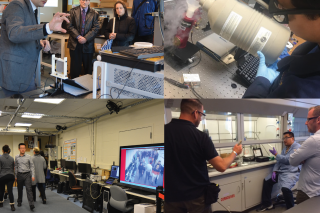News & Events
Research
ALERT Phase 2 Year 4 Annual Report Available Online! September 27, 2017
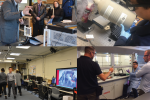
ALERT is proud to announce that the Phase 2 Year 4 Annual Report is now available for download online. This report details the continued research in ALERT’s four thrusts:
- R1 Characterization & Elimination of Illicit Explosives
- R2 Trace & Vapor Sensors
- R3 Bulk Sensors & Sensor Systems
- R4 Video Analytics & Signature Analysis
A full bibliography of publications and presentations conducted under ALERT support follows the individual project reports. Comprehensive descriptions of the Year 4 activities that took place in our Research and Transition, Education, Strategic Studies, Safety, and Information Protection Programs, as well as the ALERT Phase 2 Overview and Year 4 Highlights, Infrastructure and Evaluation, and Industrial/Practitioner and Government Partnerships can also be accessed in the Annual Report.
New Video Analytics Dataset available for use August 25, 2017
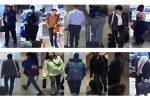
ALERT Airport Re-Identification Dataset
As part of the ALERT video analytics effort, researchers at Northeastern University and Rensselaer Polytechnic Institute developed an annotated dataset that accurately reflects the real-world person re-identification problem. The dataset was constructed using video data from the six cameras installed post central security checkpoint at an active commercial airport within the United States. (No NDA required)
Read MoreFollow ALERT on Facebook August 24, 2017
Patents Awarded to ALERT PI July 29, 2017

Dr. Rinaldi Awarded Two Patents for Resonators
Dr. Matteo Rinaldi, Associate Professor of Electrical and Computer Engineering at Northeastern University and principal investigator for Project R2-B.3, has been awarded two patents for his work on nano- and microelectromechanical resonators. Dr. Rinaldi’s research proposes to develop innovative Nano-Electro-Opto-Mechanical (NEOM) sensing technology platforms for the chemical analysis of trace explosives residues. This work contributed to the creation of the novel resonators patented earlier this month. Congratulations to Dr. Rinaldi and his research team for this exciting achievement!
Read MoreVideo Analytics Lab Hosts First CLASP Exercises July 28, 2017

On July 21, 2017, the newly launched ALERT Video Analytics Laboratory at Northeastern University’s Kostas Research Institute for Homeland Security (KRI) hosted the first exercises related to the Correlating Luggage and Specific Passengers (CLASP) research project. Supported by the DHS Science and Technology Directorate through the DHS Office of University Programs, the project is also known as “Research and Development of Systems for Tracking Passengers and Divested Items at the Checkpoint.” The July 21st exercises were conducted as a means of collecting video data of passengers moving through a mock airport security checkpoint that simulates real-world conditions.
The video data collected during these exercises will be made available to ALERT research teams from Boston University, Marquette University, Northeastern University, Purdue University, and Rensselaer Polytechnic Institute, which are working toward developing an automated system capable of tracking passengers and divested items. The primary objectives of CLASP are to assist the Transportation Security Administration (TSA) in effectively identifying security incidents like theft of items or bags left behind at the checkpoint. By automating and improving the technologies associated with these objectives, ALERT aims to increase rates of detection, while also enhancing the passenger experience.
For more information about the Video Analytics Lab and the development of the CLASP project is available here.
Summer REUs at Northeastern University and University of Puerto Rico Mayagüez July 28, 2017
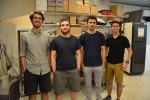
July 28, 2017
This summer, ALERT is hosting three undergraduate students to participate in the 10-week Research Experience for Undergraduates (REU) program at Northeastern University. Nikhil Phatak (Computer Engineering & Computer Science ’20), Daniel Castle (Electrical Engineering ’21), and Jacob Londa (Computer Engineering ’21) are working with Prof. Carey Rappaport and graduate student mentor, Mohammad Nemati on the Advanced Imaging Technology (AIT) project. ALERT is also hosting two REU students at the University of Puerto Rico Mayagüez.
At the end of the summer, students will give a short video presentation on their research project, which will be featured on ALERT’s website. The video presentations will consist of a brief overview of each student’s research project, the project’s overall mission and activities, their specific contributions to the project, and knowledge and skills gained.
The program is hosted and sponsored by the Awareness and Localization of Explosives-Related Threats (ALERT) Department of Homeland Security Center of Excellence, and the Bernard M. Gordon Center for Subsurface Sensing and Imaging Systems (Gordon-CenSSIS), a Graduated National Science Foundation Engineering Research Center.
ADSA16 Presentations Now Available June 20, 2017
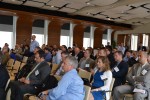
We are pleased to announce that the presentations from The Sixteenth Advanced Development for Security Applications Workshop (ADSA16) which was held on May 2-3, 2017 at Northeastern University in Boston, MA are now available for download.
The title of the workshop was, “Addressing the Requirement for Different Stakeholders in Transportation Security.” View all slides, as well as the reports from past ADSA workshops here.
If you have any questions regarding the topics and technologies discussed at the workshop, please contact ALERT at [email protected].
ALERT Launches Video Analytics Lab at Kostas Research Institute May 30, 2017
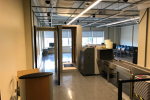
A Better Testing Facility for Solving Real World Problems
Northeastern University’s George J. Kostas Research Institute for Homeland Security is now home to ALERT’s new Video Analytics Laboratory. Providing secure access, 1225 sq. feet of open space, controlled lighting conditions, and a fully networked and flexible camera grid, ALERT can better investigate and develop video and sensor technologies to address the needs of the Homeland Security Enterprise.
Using Video Technologies to Improve Passenger Experience
The first research project to leverage the lab is entitled Research and Development of Systems for Tracking Passengers and Divested Items at the Checkpoint. Supported by the DHS Science and Technology Directorate through the DHS Office of University Programs, this project is known by the acronym CLASP (Correlating Luggage and Specific Passengers) and leverages the technical expertise of ALERT research teams from Boston University, Marquette University, Northeastern University, Purdue University, and Rensselaer Polytechnic Institute. These teams will work towards developing an automated system capable of tracking passengers and divested items at airport security checkpoints.
CLASP will primarily focus on using video technologies to assist the Transportation Security Administration (TSA) in effectively identifying security incidents like theft of items, or bags left behind at the checkpoint. By automating and improving the technologies associated with these objectives, ALERT hopes to improve rates of detection and at the same time improve the passenger experience.
CLASP was the result of DHS’s interest in initial work done by ALERT Project Investigator Richard Radke’s lab. A video of their work can be seen below:
(Z. Wu and R.J. Radke, Real-Time Airport Security Checkpoint Surveillance Using a Camera Network. Workshop on Camera Networks and Wide Area Scene Analysis, in conjunction with CVPR 2011, June 2011.).
Government & Industry Partners Make the Difference
In order to deliver the system outlined in CLASP, the researchers working on the project require access to video data displaying real-world checkpoint security situations. Actual airport security video is generally restricted, so ALERT partnered with Massport, the Transportation Security Administration at Boston Logan International Airport, and industrial partners such as Rapiscan Systems to create an accurate representation of an airport security checkpoint in the ALERT Video Analytics Laboratory. This full-scale, mock airport security checkpoint uses the same hardware and design specifications currently used by the TSA at airports such as Logan, and gives ALERT a space to generate usable video data for this project and hopefully to the video analytics research community as a whole.
CLASP is just the beginning of work that can be done in this new laboratory and ALERT is hoping to leverage it for additional homeland security-related projects going forward. If you are interested in partnering with ALERT on future projects, please connect with us via email at [email protected].
Industry Spotlight: Q&A with Dr. Mark Witinski of Pendar Technologies May 30, 2017

ALERT recently caught up with Dr. Mark Witinski, Vice President of Chemical Analysis & Security Group, at Pendar Technologies. Dr. Witinski served as co-founder and President of Eos Photonics prior to the merger which formed Pendar Technologies. At Pendar Technologies, he focuses primarily on applications development, business to business strategic partnerships, and government sales.
1) Can you describe the work Pendar Technologies does and how it contributes to the Homeland Security Enterprise?
Pendar’s work in furthering the Homeland Security Enterprise takes a few forms. The most critical one – the one that is the focus of our first product – is giving security and military personnel the tools to analyze unknown chemicals in the field and without physical contact. This is generally referred to as “Standoff Detection.”
2) Pendar Technologies is one of ALERT’s industrial members. How has collaboration with ALERT been beneficial to Pendar Technologies?
For Pendar, there are two major benefits to our longstanding ALERT membership. One is direct interaction with thought leaders in the Homeland Security space, where we learn first-hand about the contemporary challenges and frontiers in various security settings. The other major benefit has been formal and informal collaborations with other members of the ALERT community that serve to address those challenges. For instance, Pendar has pursued new sensing modalities with other industrial members and has also fostered collaborations with academic research groups from ALERT affiliated universities including: Northeastern University, Purdue University, Tufts University, The University of Rhode Island, and The University of Puerto Rico.
3) Can you describe some of the technology that has been developed or improved upon through the Pendar Technologies/ALERT partnership?
Sure. Pendar uses a unique laser technology called the Quantum Cascade Laser. Critical advancements in that technology were made through two years of partnership with ALERT and The John Adams Institute for Innovation (JAII). This work was especially important as it came during a very formative time in our company. Working with ALERT and JAII helped to reduce the market risk pursuing the technological path that we were on.
4) You completed your doctorate in Chemical Physics at Cornell University where your research focused on molecular beams and laser spectroscopy to examine the dynamics of molecular collisions. What inspired you to pursue this research area?
This is an interesting question—one I even ask myself sometimes. My graduate work, and my postdoc work for that matter, were both focused on gas phase chemistry. Specifically, I sought to examine the detailed aspects of individual molecular reactions to gain the understanding that underpins how, for instance, ground level pollutants form and how they are removed. The atmosphere is a reactor—a very large and hard to control reactor. As a health matter, dangers lie not only in exposure to chemicals that are directly emitted. Rather, substances and their levels are governed by a complex set of coupled reactions, reactions which I wanted to understand as fully as possible before even attempting to comment on a solution. In this process, I became exposed to many laser technologies, including the Quantum Cascade Laser.
5) Can you describe your current role at Pendar Technologies and how your technical background prepared you for this role?
What I try to do is to listen to leaders from the agencies that all of us rely on to enhance our security. Often, these conversations reveal that many agencies, as well as the Defense Departments of the world share similar needs, although they may not communicate directly with one another. If a security capability is both desired and is lacking in multiple user groups, it tells me that a new capability is truly needed for protection of the public and of military forces. I then work with other Pendar scientists and engineers to see if we can offer a solution.
6) What emerging technology or research in the chemical analysis and security domains are you most excited about?
One of the things about chemical analysis that is not immediately obvious is that, at the most fundamental of levels, we basically have the tools that we are going to have for the foreseeable future: Mass Spectrometry, Infrared Spectroscopy, Chromatography, Raman Spectroscopy, X-Ray Imaging, Ion Mobility Spectrometry, and the list goes on.
What advances the capabilities of these methods is how they are practiced and integrated in a way that leverages advances in other disciplines. For instance, modern systems are engaging high speed portable computing, ever improving camera systems, additive manufacturing technology, wireless communications, etc… It is through careful integration and mastery of the entire chemical/instrument/user system that disruptive advances occur. It seems clear that the necessity of end-to-end mastery in this space is causing security developers to collaborate more, and venues like ALERT are key in fostering needed collaborations.
Kurt Jaisle Selected as Finalist in IEEE AP-S Student Paper Competition May 30, 2017
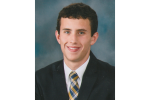
May 30, 2017
ALERT student researcher and Northeastern University Scholar, Kurt Jaisle has been selected as a finalist in the 2017 IEEE Antennas and Propagation Symposium’s (AP-S) Student Paper Competition for his paper, “Ray-Based Reconstruction Algorithm for Multi-Monostatic Radar in Imaging Systems.”
Being selected as a finalist is quite an accomplishment, as each paper submitted to the IEEE AP-S Student Paper Competition undergoes three independent reviews from experts in each student’s field of study. Jaisle’s submission was selected out of 159 papers, most of which were submitted by doctoral students. Kurt is a third year undergraduate student majoring in Electrical and Computer Engineering and conducts ALERT research with Professor Carey Rappaport on the R3 Research Thrust (Bulk Sensors & Sensor Systems).
Jaisle believes that the topic of his paper is relevant to aviation security and the Homeland Security Enterprise: “Today’s airport security scanners use very computationally demanding algorithms to process sensor data into an image of a passenger. As a result, these scanners require expensive, high-performance computers to complete the algorithms in a reasonable amount of time. Yet even with these powerful machines, it can still take several seconds for a scan to be processed.” In his paper, Jaisle proposes a new algorithm that would result in significantly faster processing times resulting in shorter lines for passengers at airport security checkpoints, and a reduction in the cost of the computer hardware used in scanners, potentially making the technology more accessible for broader security applications.
Under the guidance of Professor Rappaport, Jaisle began coding the algorithm in Fall 2015. Over the course of a year, he managed to bring the algorithm from a rudimentary 2D simulation to a functional 3D simulation worthy of publication. Reflecting on his experience conducting research with Professor Rappaport, Jaisle states, “Aside from a great deal of technical knowledge, I think the most important thing I have learned from Professor Rappaport is to not leave an endeavor half-finished. Even when I was stuck on a technical challenge for weeks at a time, he would remind me that progress in research is non-linear and that it was worth seeing it through so that I could eventually share my work with the broader community.”
Jaisle’s interest in engineering was sparked during middle school, when he became involved in FIRST Robotics, a program that aims to develop young STEM leaders through robotics competitions. As time passed, he became interested in the electrical side of engineering and decided to pursue this field of study at Northeastern University. After graduation, Jaisle plans to pursue a Master’s Degree in the context of analog electronics, and is hoping that his upper level Electrical Engineering courses, co-op opportunities, and research experiences will help him choose a specific topic of study.
Jaisle will present on his selected paper at the IEEE AP-S Symposium in San Diego, California in July. Following the presentations, the Student Paper Competition Committee Chair will announce the first, second, and third place winners at the IEEE A-PS Symposium’s Annual Awards Ceremony.

